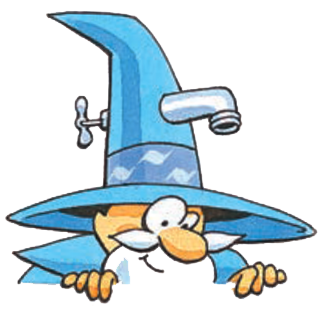Hey Kids
This is YOUR place to learn more about your water! Start by clicking on a topic below!

Teachers
It is in our best interest to provide you, the educators in our community, with material that can assist you in the classroom. We have put together a variety of water experiments that you can use in the classroom.

Reading List
We’ve put together this list to help you learn more about water, conservation, and marine life. See your local bookstore for availability and other great educational titles!

Alum (Aluminum Sulfate): Added in the drinking water treatment process causing particles to clump together and fall to the bottom of the settling basins.
Anthracite: A hard coal used in the drinking water treatment process to remove particles.
Aquifer: An underground layer of rock or soil that holds the water referred to as groundwater.
Chlorine: A liquid or gas chemical that is used as a disinfectant in the drinking water treatment process.
Coagulation: The process by which coagulant compounds are mixed into the water to neutralize electrical charges on small impurities and come together to form larger particles.
Condensation: The change of water from a gas to a liquid.
Contaminant: Anything added to a substance that makes it impure.
Disinfection: A chemical process used to kill any germs in the water.
Distribution System: The process by which water is sent from the treatment plant to homes and businesses.
Drought: A deficiency of precipitation over an extended period of time.
Evaporation: The process where water becomes vapor in the atmosphere.
Filtration: The process in which a liquid is passed through a filter to remove any dirt or impurities.
Floc: The large particles produced from coagulated particles binding together.
Fluoride: A compound that is sometimes added to drinking water in an effort to help prevent tooth decay.
Greywater: Domestic wastewater such as water from tubs, showers or washing machine water.
Groundwater: The water beneath the surface of the ground.
Hardness: A characteristic of water caused by mineral salts of magnesium and calcium.
Nonpoint Source Pollution: Pollution that cannot be traced to one specific location. It may include rainwater runoff or fertilizer from fields.
Ozone: A gas used in the water treatment disinfection process.
Percolate: Soaking of water through the soil.
pH: A measure of acidity and alkalinity of a solution, represented by a number on a scale.
Precipitation: Water in the form of rain, sleet, hail or snow.
Reservoir: A man-made lake that holds and stores water.
Residual Solids: Settled solids from the sedimentation segment of the treatment process.
Riparian Buffer: The green areas along the banks of streams, rivers, lakes and ponds. These areas are important for water quality, flood storage and cover and shade for plants and animals.
Runoff: The portion of rain that is not absorbed into the soil but flows into streams.
Sediment: A mineral or organic solid that is washed from the land into lakes, streams, or rivers.
Sedimentation: The process where solids suspended in water settle to the bottom of a basin.
Source: Where a stream or river begins.
Surface Water: Water located on the surface of land, such as rivers, lakes, and ponds.
Transpiration: The process whereby water vapor is given into the atmosphere by living plants.
Turbidity: The cloudy or muddy appearance of a naturally clear liquid caused by the suspension of particles.
Water Conservation: Protecting and preserving the amount of water you use.
Water Cycle: The process by which water renews itself.
Water Meter: A device that measures the quantity of water coming into your home or business.
Watershed: The area where water drains from the land into a common body of water, such as a river, lake or ocean.
Water Treatment: The process of cleaning water.
Well: A deep hole drilled in the ground to obtain water.
Xeriscaping: Landscaping technique designed to minimize the need for watering.
Water Distribution / Forest Park Water Treatment Plant
The Forest Park Water Treatment Plant currently exists as one of the most technologically advanced water treatment plants in the United States. This state-of-the-art facility was designed to meet the future water regulations and the growing population in both Bucks and Montgomery counties.
Water treatment may vary in the different communities, depending on the source and quality of the water. Come along as we follow the water through a typical treatment plant!
After the water enters the treatment plant, coagulation removes dirt and other particles suspended in water. Alum and other chemicals are added to water to form tiny particles called floc which attract the dirt particles. The combined weight of the dirt and the alum become heavy enough to sink to the bottom during sedimentation.
Sedimentation: The heavy particles (floc) settle to the bottom of the basin and the clear water moves to filtration.
Filtration: The clarified water flows to an advanced microfiltration stage where microscopic particles are filtered out by submerged membranes.
Disinfection: A small amount of chlorine is added as a final process to kill any bacteria or microorganisms that may be in the water. This ensures that when the water reaches your home, it is safe for your entire family.
A water meter is a device that measures the amount of water coming into your home. Water meters may be located in your basement, utility closet or in a meter pit outside of your home.
A meter reader reads the meter on a monthly or quarterly basis. The meter reader may obtain your reading from an automatic meter reading system via a computer or they may need to walk up to the meter to obtain the reading. We then bill you for the amount of water that you have used.

The Low Flow Indicator…
Moves when small amounts of water pass through your meter. This helps in detecting leaks.
The 10 Gallon Dial…
Measures the use of 10 gallons of water for each complete revolution.
The Gallon Readings…
Are wheels that measure the number of gallons that have passed through that meter. They increase from left to right and measure tens of gallons, then hundreds, thousands, ten thousands, hundred thousands, and then millions.
We’ve put together this list to help you learn more about water, conservation, and marine life. See your local bookstore for availability and other great educational titles!
Elementary School
- Common Ground: The Water, Earth, and Air We Share by Molly Bang
- The Drop in My Drink by Meredity Hooper and Chris Coady
- A Drop of Water: A Book of Science and Wonder by Walter Wick
- The Earth and I by Frank Asch
- The Magic School Bus: At the Water Works by Joanna Cole
- The Magic School Bus: Wet All Over by Joanna Cole
- The Magic School Bus: On the Ocean Floor by Joanna Cole
- The Magic School Bus: Takes a Dive by Joanna Cole
- I Am Water (Hello Reader! Science Series) by Jean Marzollo
- Water by Frank Asch
- Water, Science, Water Fun: Great Things to do with H2O by Noel Fiarotta and Phyllis Fiarotta
- Where Does Water Come From? by C. Vance Cast
- Where Do Puddles Go? by Fay Robinson
Middle School
- Clean Water by Karen Barss
- Drought by Christopher Lampton
- Every Drop Counts by Jill C. Wheeler
- Water Conservation: Student Edition by Leslie Crawford
- Water Squeeze by Mary O’ Neill
- Ground Water and Surface Water: A Single Resource U.S. Geological Survey
- Water: A Natural History by Alice Outwater
- Water Wars: The Fight to Control and Conserve Natures’s Most Precious Resource by Olga Cossi
- Water: Almost Enough for Everyone by Stephanie Ocko
- Tapped Out by Paul Simon
Other
- 50 Simple Things Kids Can Do to Save the Earth by Andrews and McMeel
- Adventures in Greater Puget Sound by Dawn Ashbach
- Can It Rain Cats and Dogs: Questions and Answers about Weather by Melvin Berger
- Eyewitness Series – Pond and River
- The Great Kapok Tree: A Tale of the Amazon Rain Forest by Lynne Cherry
- Habitats – Pond and Stream by Norris, O’Brien, Law
- The Mysterious Ocean Highway: Benjamin Franklin and the Gulf Stream by Deborah Heligman
- The Ocean Book by Isaac Asimov
- Ponds and Streams by John Stidworthy
- Protecting Rivers & Seas by Kamini Khanduri
- River Life: A Close-up Look at the Natural World of a River by Barbara Taylor
- A River Ran Wild: An Environmental History by Lynne Cherry
- Rivers and Oceans by Barbara Taylor
- The River by David Bellamy
- Sam the Sea Cow by Francine Jacobs
- Science Poems and Songs for Young Learners by Meish Goldish
- Water by Ava Drutman
- Why the Sea is Salty by Vivian French
- Oceans by Lisa Molengraft
- Experiments with Water by Bryan Murphy
- Water’s Way by Lisa Peters
- Using Water Series from Scholastic
- See What’s in the Sea by P. Dunlap Grosset
- Way Down Deep: Strange Ocean Creatures by Patricia Brenna Demuth
- My Life with the Wave by Catherine Cowan
Water Links for Kids
US Geological Survey Water Cycle For Kids: A fun water-cycle diagram for kids of all ages.
US EPA’s Explorers’ Club: Do you want to make the earth a cleaner place to live? How can you help to protect the air, water, and land? Explore this site to find out what you can do!
USDA Natural Resources Conservation Service: Learn what a watershed is and why it’s important to you!
The Groundwater Foundation Kids Corner: learn what groundwater is all about and why it is so important.
EPA Office of Ground Water and Drinking Water: games and activities that will help you learn about drinking water.
U.S. Geological Survey’s Water Science for Schools: information on many aspects of water, along with pictures, data, maps, and an interactive center where you can give opinions and test your water knowledge.
The Water Page: practical tips for saving water and lots of resources for learning more about water.
Aquatic Insects: learn all about aquatic insects and how they help us determine the health of a waterway

Contact
To be a recognized community leader by creating customer solutions, adding value to our services, and maintaining competitive rates through the implementation of sound business practices.